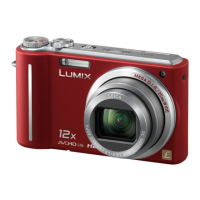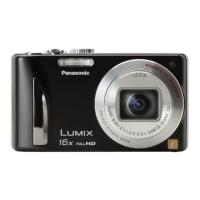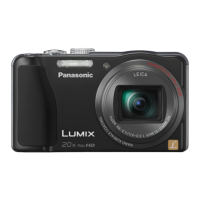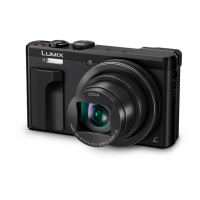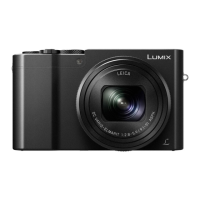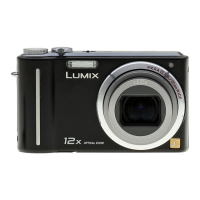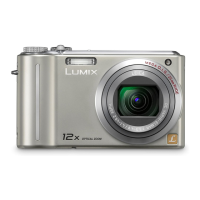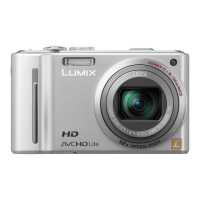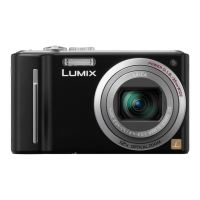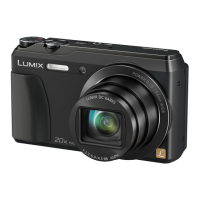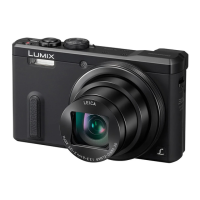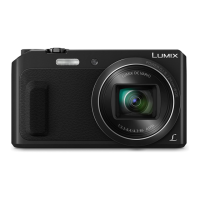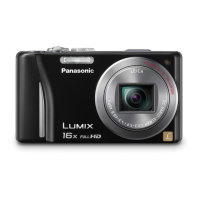
Do you have a question about the Panasonic Lumix DMC-ZS10 and is the answer not in the manual?
| Camera Type | Compact |
|---|---|
| Effective Pixels | 14.1 MP |
| Optical Zoom | 16x |
| Digital Zoom | 4x |
| Screen Size | 3.0 inches |
| Sensor Size | 1/2.33 inch |
| Image Stabilization | Optical |
| Maximum Video Resolution | 1920 x 1080 |
| Video Resolution | Full HD |
| GPS | Yes |
| LCD Screen Resolution | 460, 000 dots |
| Battery Type | Lithium-Ion |
| Shutter Speed | 60 - 1/4000 sec |
| Battery Life | Approx. 260 shots |
Safe handling to prevent damage and misuse, including avoiding vibration and dust.
Explains lens clouding due to temperature changes and how to resolve it.
Covers test shots before events, no compensation policy, and copyright observance.
Explains location name info, recording, and the GPS positioning process.
Guidance on GPS usage in foreign countries and potential restrictions.
Lists included items and optional accessories like memory cards.
Identifies key buttons, dials, and connection sockets on the camera.
Warns about counterfeit batteries and specifies compatible types.
Step-by-step guide on how to charge the battery using the charger.
Estimates for still picture count and recording time based on CIPA standards.
Details recording time for AVCHD and Motion JPEG formats.
Step-by-step instructions for inserting the battery and card.
Instructions on how to safely remove the battery and card.
Details the process of connecting the AC adapter and DC coupler for uninterrupted power.
Explains where pictures are saved and compatible memory card types.
Explains how to check status and provides recording capacity estimates.
Explains the function of the mode dial, shutter button, zoom lever, and other buttons.
Explains how to interact with the touch screen using touch and drag gestures.
Details the use and precautions for the included stylus pen.
Step-by-step guide for setting the date and time for the first time.
Explains how GPS can be used to set the clock automatically.
Describes how to access and change the clock settings from the menu.
Covers turning on the camera, setting the REC/PLAY switch, and selecting recording modes.
Instructions for shooting and proper camera holding technique.
Explains how to use the Program AE mode for custom settings.
Describes how to adjust focus when the subject isn't in the center using the AF area.
Details how to use the touch screen to focus and take pictures.
Explains how touching the screen sets focus and exposure.
Describes the automatic settings and scene detection features.
Explains flash modes, color settings, and iHandheld Nite Shot.
Details how to use AF tracking with cursor buttons and touch operations.
Summarizes available menu items, fixed, and unavailable functions.
Explains how to start and stop recording videos.
How to record videos with preferred or automatic settings.
Refers to other modes for motion picture recording.
Explains how to scroll through images and display information.
How to select and play back recorded videos.
Describes controls for pause, stop, fast forward, rewind, and volume.
How to zoom in and out of pictures during playback.
How to view multiple pictures or by calendar date.
How to select dates to view pictures taken on specific days.
Step-by-step process for deleting the currently displayed picture.
Explains how to delete multiple pictures or all pictures, including exceptions.
Explains the layout and buttons used in the menu system.
General steps for navigating and changing settings via the menu.
A practical example of navigating menus to change a specific setting.
Lists the different menus available (Rec, Motion Picture, GPS, Setup, Playback).
Explains how to quickly access and change settings during recording.
Covers clock setting, auto clock setting via GPS, and world time.
Explains how to record travel dates and locations.
How to adjust volume and tone of sounds.
Covers adjusting speaker volume and LCD brightness modes.
Explains how to display grid lines for composition.
Explains histogram for brightness checking and recordable area for video.
How to remember zoom position after power off.
Covers power saving modes and automatic picture review.
Explains resetting file numbers and restoring default settings.
How to select PC or PictBridge mode for USB connection.
Covers TV aspect ratio, VIERA Link for device linking.
Setting how 3D pictures are output.
Setting for rotating pictures and checking firmware version.
Explains when and how to format storage.
How to calibrate the touch screen if it's unresponsive.
Changing display language and viewing product demonstrations.
Explains how to use the zoom lever and touch gestures for zooming.
Describes the different zoom capabilities and their applications.
Details the different flash modes (Auto, Red-Eye, Forced On/Off, Slow Sync).
Table showing which modes support flash.
Information on flash effective range and associated shutter speeds.
Warnings and tips regarding flash usage, red-eye reduction, and charging.
How to use AF Macro for close-up shots.
Explains the Macro Zoom feature for even larger close-up images.
Table showing shortest focusing distances for different zoom ratios and macro modes.
Step-by-step guide to using the self-timer for delayed shots.
How to manually adjust exposure for brighter or darker images.
Explains the auto bracket feature for capturing multiple exposures.
How to control depth of field by setting aperture.
How to control motion blur by setting shutter speed.
Detailed guide on setting aperture and shutter speed manually.
Explains the on-screen assist for manual exposure.
How to save and recall custom camera settings.
How to use the mode dial to switch to custom settings.
How to use scene modes for optimal settings based on the subject.
Explains video recording behavior in specific scene modes.
How to register frequently used scene modes for quick access.
Describes specific scene modes for portraits and subject appearance.
Instructions and tips for self-portraits and distant subjects.
How to capture images for creating panorama pictures.
Details for capturing fast movement and low-light portraits.
Instructions for night scenes and handheld low-light shots.
How to take natural-looking food pictures.
Usage for indoor events and candlelit scenes.
Features for recording age and name for babies and pets.
How to capture sunsets and prevent blur in dim conditions.
Continuous shooting in low light and capturing starry skies.
Usage for fireworks, beach, and snow scenes.
Instructions for aerial shots, retro effects, and grainy textures.
How to reduce over/underexposure in high contrast scenes.
How to add frames and capture underwater scenes.
Recording rapid movements at high frame rates.
How to set the mode dial for 3D photography.
Instructions on how to capture 3D images by moving the camera.
Advice and restrictions for 3D photography.
Details different burst speed options and their descriptions.
Further details and restrictions on burst shooting.
Explains the function of face recognition during recording and playback.
Advice for successful registration and what to do if recognition fails.
Step-by-step guide to registering faces, names, and ages.
How to modify or remove registered face information.
Explains GPS basics and how positioning works.
Tips for getting a good GPS signal and avoiding interference.
How to enable/disable GPS and check reception status.
Specific guidance for using GPS in restricted areas like airplanes.
Explains status icons and what GPS data is recorded with images.
Explains how location names are sourced and displayed.
How to manually trigger positioning or update location data.
How the camera handles positioning automatically and how to check reception status.
How to edit or select nearby place names for recorded locations.
How to prevent place names from being recorded.
How to add custom landmarks to the camera's database.
Managing custom landmarks.
Customizing which location details are shown.
How GPS time synchronization works.
How to record travel dates for pictures.
How to manually add location details for travel.
How to set the camera's clock to a different time zone for travel.
Explains how to enter text using the cursor and on-screen keyboard.
How to change aspect ratio and select picture resolution.
How to set image quality and adjust ISO sensitivity.
How to adjust colors to match lighting, including fine-tuning.
Procedure for setting white balance manually using a reference object.
Explanation of different autofocus modes like Face Detection, AF Tracking, etc.
Details AF mode limitations and the Quick AF feature.
How focus behaves in various scene modes.
Covers face recognition, light metering, and contrast/exposure adjustment.
Settings for minimum shutter speed, intelligent resolution, and digital zoom.
Details burst shooting, color effects, and AF assist lamp usage.
How to automatically correct red-eye and prevent image blur.
How to add date and time stamps to pictures.
Accessing clock settings from the Rec menu.
How to select video recording formats.
Explains different quality settings for AVCHD and Motion JPEG.
How to stabilize video and manage autofocus.
How to reduce wind noise during recording.
How to capture still photos while recording a video.
How to use burst mode while recording video.
How to extract a still frame from a video.
How to divide a video into two parts.
Explains how burst pictures are displayed and managed.
What to do if burst group data is lost or corrupted.
Overview of different ways to play back recorded content.
How to create and view automated slideshows.
How to customize slideshows with effects, duration, and sound.
Controls for navigating slideshows.
How to filter pictures by category, GPS location, travel date, etc.
How to view pictures by date using a calendar interface.
How to select pictures for uploading to image-sharing websites.
How to add titles to still pictures.
How to edit location names recorded by GPS.
How to stamp text, dates, and names onto pictures.
Lists all the data that can be added as stamps.
Refers back to splitting motion pictures.
How to reduce the size of pictures for email or web use.
How to enlarge and crop unwanted areas of pictures.
How to mark pictures as favorites for easy playback or deletion.
How to set printing preferences for compatible printers or shops.
How to set protection to prevent accidental deletion of pictures.
How to edit or delete face recognition information for mistaken identifications.
How to copy pictures between built-in memory and memory cards.
Steps for connecting and viewing pictures on a TV using AV cables.
Notes for TVs or DVD recorders with SD card slots.
Steps for connecting and viewing pictures in high resolution via HDMI.
Explanation of VIERA Link for easy device control and operation.
How to connect to a 3D TV and view 3D content.
How to filter and play back only 3D images.
Notes on available/unavailable functions during 3D playback.
How to copy content to Blu-ray/DVD recorders using an SD card.
How to dub videos to media like DVD discs using AV cables.
How to use the provided software to copy files to a PC.
Specific instructions for managing 3D images.
Table showing compatibility with Windows/Macintosh OS for software.
Steps for establishing a USB connection between camera and PC.
General advice on computer operations and cancellation.
Explains how camera files are organized on a computer.
How to use the LUMIX Image Uploader tool for online sharing.
Steps for connecting the camera to a PictBridge-compatible printer.
Process for choosing images and initiating printing.
How to print several pictures at once.
Options for adding date and text to printed photos.
How to configure print options like date, number of copies, and paper size.
Explains various icons and information shown on the LCD during recording.
Explains various icons and information shown on the LCD during playback.
Lists various error messages and how to resolve them.
Explains specific error messages related to memory cards and data.
Troubleshooting for camera not turning on or shutting off unexpectedly.
Troubleshooting for GPS not working or taking too long.
Covers issues like 'Cannot record pictures', 'Pictures look white', 'Pictures too bright/too dark'.
Troubleshooting for focus alignment and blurred pictures.
Addresses color differences and LCD monitor issues.
Troubleshooting for video recording stopping midway or AF track failures.
Troubleshooting for flash not emitting, multiple flashes, rotated pictures, and incorrect dates.
Troubleshooting for no image, blurred image, or incorrect aspect ratios on TV.
Issues with playing motion pictures on other cameras or computers.
Specific issues with HDMI connectivity and VIERA Link.
Troubleshooting for PC not recognizing the camera or card.
Troubleshooting for language, camera rattles, hot camera, clicking lens, incorrect clock.
Troubleshooting for zoom stopping, file number errors, and automatic demo display.
Warnings about electromagnetic interference, handling, and heat.
Instructions for cleaning and maintaining the camera.
Advice on storing the camera and battery.
Precautions for preventing damage to memory cards and data.
Information about the LCD screen's behavior and potential spots.
Important notes and warnings related to charging the battery.
Instructions for cleaning the lens and protecting it.
Cautions when attaching accessories to the camera.
Safety advice and recommendations for viewing 3D content.
How personal data in the camera is handled and protected.
Legal agreement for using location data.
Legal disclaimers regarding the product and data.
Legal terms related to export and the complete agreement.
Information about WGS84 and map data usage.
States the camera does not have navigation features.
Lists various types of points of interest stored in the camera.
